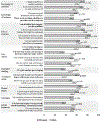Men and women experience different barriers to care seeking for fecal incontinence
- PMID: 37614056
- PMCID: PMC10810259
- DOI: 10.1002/nau.25266
Men and women experience different barriers to care seeking for fecal incontinence
Abstract
Background: Despite effective treatments for fecal incontinence (FI), FI remains underdiagnosed and undertreated. This study sought to characterize and compare rates of, delays in, experiences with, and barriers to care seeking for FI among men and women.
Methods: This study was a secondary analysis of electronic survey data collected from adults with FI. The survey included the use of a validated instrument to assess FI severity and questions that now comprise a validated instrument for assessing barriers to care seeking for FI in women. Descriptive analyses characterized differences between men and women. χ2 testing for categorical variables and t-testing for normally distributed continuous variables compared statistical differences.
Results: The sample (N = 548) was predominately female (84%), non-Hispanic White (90%), and insured (96%), with a mean Vaizey score (13.4 ± 5.3) consistent with moderate or severe FI. Care seeking rates (p = 0.81) and symptom duration before care seeking (p = 0.23) did not differ between women and men, but women were more likely than men to be told that effective treatments exist; most male and female respondents who sought care were offered treatment. Very few respondents had been asked about FI by a healthcare provider. Whereas normative thinking, limited life impact, and believing that a healthcare provider could not help were more common barriers to care seeking among men, avoidance, fear, and discouragement were more common in women.
Conclusions: Men and women with FI seek care at similar rates and after experiencing symptoms for a similar duration of time. Very few patients with FI have been screened for it by a healthcare provider. Barriers to FI care seeking are different for women and men, and men are less likely than women to be informed about effective treatments by a healthcare provider.
Keywords: accidental bowel leakage; barriers to care; fecal incontinence; female; male; quality of life.
© 2023 The Authors. Neurourology and Urodynamics published by Wiley Periodicals LLC.
Conflict of interest statement
Figures


Similar articles
-
Validation of an instrument to assess barriers to care-seeking for accidental bowel leakage in women: the BCABL questionnaire.Int Urogynecol J. 2017 Sep;28(9):1319-1328. doi: 10.1007/s00192-016-3261-8. Epub 2017 Feb 24. Int Urogynecol J. 2017. PMID: 28236039 Free PMC article.
-
Factors that affect consultation and screening for fecal incontinence.Clin Gastroenterol Hepatol. 2015 Apr;13(4):709-16. doi: 10.1016/j.cgh.2014.08.015. Epub 2014 Aug 19. Clin Gastroenterol Hepatol. 2015. PMID: 25148761 Free PMC article.
-
Barriers to seeking care for accidental bowel leakage: a qualitative study.Int Urogynecol J. 2017 Apr;28(4):543-551. doi: 10.1007/s00192-016-3195-1. Epub 2016 Nov 14. Int Urogynecol J. 2017. PMID: 27844123 Free PMC article.
-
Prevention of urinary and fecal incontinence in adults.Evid Rep Technol Assess (Full Rep). 2007 Dec;(161):1-379. Evid Rep Technol Assess (Full Rep). 2007. PMID: 18457475 Free PMC article. Review.
-
Eliciting Help-Seeking Behaviors in Patients With Fecal Incontinence: Supporting Timely Access to Treatment.Home Healthc Now. 2016 Sep;34(8):424-33. doi: 10.1097/NHH.0000000000000445. Home Healthc Now. 2016. PMID: 27580281 Review.
Cited by
-
Post-Market Study Evaluating Performance of the Rechargeable InterStim™ Micro System in Fecal Incontinence Patients.Int Urogynecol J. 2025 Apr;36(4):913-921. doi: 10.1007/s00192-025-06127-9. Epub 2025 Apr 5. Int Urogynecol J. 2025. PMID: 40186665 Clinical Trial.
References
-
- Bharucha AE. Fecal Incontinence. https://gi.org/topics/fecal-incontinence/#tabs2
-
- Johanson JF, Lafferty J. Epidemiology of fecal incontinence: the silent affliction. Am J Gastroenterol. Jan 1996;91(1):33–6. - PubMed
MeSH terms
Grants and funding
LinkOut - more resources
Full Text Sources

